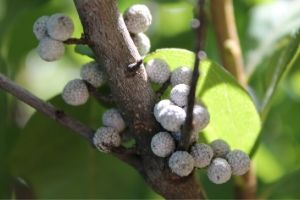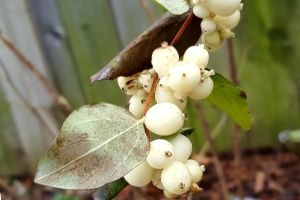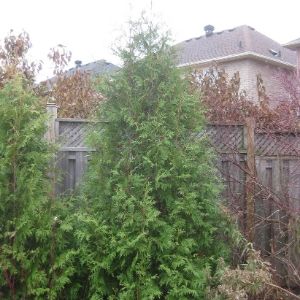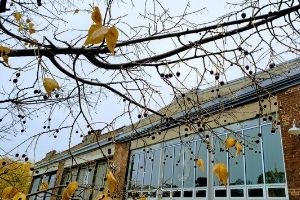Why plant native? Native trees and shrubs have adapted to our local soils and climate over thousands of years, supporting the co-evolution of native wildlife by providing essential food and shelter- especially during our harsh, food-scarce winters. To create excellent winter food and shelter in your yard and outdoor spaces, we recommend…

Bayberry (Myrica pensylvanica)
This semi-evergreen shrub has dense branching and foliage that persists into the winter, which wildlife can use for shelter. The fruit also remains on the branches throughout the winter season providing a food source for birds, like grosbeaks and black-capped chickadees. For fruit production, homeowners should plant two or more shrubs as male and female flowers are generally found on separate shrubs.

Bur oak (Quercus macrocarpa)
The acorns of this oak are jam-packed full of nutrients and persist on the tree into the winter, making them a popular food source among birds and mammals such as squirrels and deer. The bur oak is also a large-growing tree that provides shade and privacy for homeowners and ample shelter for wildlife as it sometimes holds onto its leaves through the winter.

Common snowberry (Symphoricarpos albus)
This shrub is named for its white berries that ripen in early fall and persist into winter, becoming a food source for chipmunks and overwintering birds, like robins and thrushes. When grown in a thicket, the spreading branches of this shrub can provide important winter cover for these animals while they enjoy its fruit. The snowberry can also grow in a range of soil and sunlight conditions, and is a fairly small shrub, making it a suitable for most backyards.

Eastern white cedar (Thuja occidentalis)
The year-round foliage of this small evergreen tree offers wildlife refuge from the harsh winter weather and cover from predators, especially when planted in a hedgerow. This cedar produces cones in the spring which then release seeds in the fall, over a period of several months. These seeds are an attractive food source for overwintering finches, like the goldfinch. The eastern white cedar is ideal for property owners looking to create privacy in a natural way.

Hackberry (Celtis occidentalis)
This tree is an important food source for small mammals and birds because its small, black, sweet fruit remains on the tree throughout the winter. Cedar waxwings, robins, cardinals and other birds enjoy these late-season fruits. The hackberry can tolerate compacted clay soil and is a great choice for property owners living in new developments.

White spruce (Picea glauca)
This large evergreen tree has year-round foliage thick enough to hide and protect a variety of wildlife from predators and winter weather. The cones of this tree open up and shed seeds throughout the winter months, making it a great food source for seed-eating birds and squirrels. The white spruce is an ideal choice for homeowners looking for year-round greenery and to create a windbreak on their property.
There are many ways humans can help urban wildlife, such as installing bird or bat boxes. If you keep a bird feeder, it must be washed with hot, soapy water once a week and refilled with fresh seed once dry to avoid the spread of disease – so much work! So the best way to help urban wildlife is to help the urban forest they call home!
When planning your outdoor space, we encourage everyone to ensure you’re planting the right species for you and your property. LEAF offers subsidized tree and shrub planting services which include a consultation with an ISA certified arborist.
If you have a wildlife-friendly yard, consider getting it certified through the Canadian Wildlife Federation!
Jess Wilkin is the Residential Planting Programs Operations Coordinator. She holds a Master’s of Forest Conservation from the University of Toronto.
The #BackyardBiodiversity campaign is a partnership initiative with the Toronto Wildlife Centre and is supported by Ontario Power Generation.
LEAF offers a subsidized Backyard Tree Planting Program for private property. The program is supported by The Town of Newmarket, The Regional Municipality of York, City of Toronto, Toronto Hydro, Town of Ajax, and Ontario Power Generation. For details on how you can participate, visit http://yourleaf.org.
